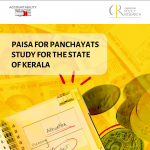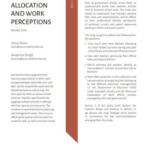
Closing the Expenditure Cycle – From Outlays to Outputs to Outcomes
21 March 2011
Into its second year, PAISA2010 has expanded in its ambition, scope and analysis. If last year’s report was a statement of intent, this year the PAISA process has matured into a comprehensive expenditure tracking project, of which this report is only one part. There have been significant initiatives in state-level advocacy, district and block-level surveys, training and community mobilization at the school management committee level. The findings of PAISA 2009 formed the core of the advocacy agenda of this wider project.
One important lesson learnt over two years of doing PAISA is that any meaningful expenditure tracking effort needs to engage with policymakers, implementation officials at the state, district and block, and frontline providers, including the community groups tasked with oversight in implementation of large Centrally Sponsored Schemes (CSS) such as the Sarva Shiksha Abhiyan (SSA). If any of these links are weak, it would lead to a situation where outlays do not match the needs, and outputs are not adequate. To close the expenditure cycle, we need to be able to connect the outlays and outputs to outcomes.
The fundamental problem in elementary education today is that increased allocations are not translating into better outcomes. This year’s PAISA Report provides the tables for learning levels from ASER to enable a comparison of total and per child expenditure under SSA, fund flow and fund utilization, the status of basic amenities such as drinking water and toilets, and the enrolment/attendance levels in government schools in the states. What we find is interesting –allocations are on the rise, funds are reaching schools albeit with a significant lag, amenities exist but are not always usable. Crucially, funds are utilized but for very limited set of items, which are mostly concerned with office expenditure and infrastructure. And while the links between expenditures and outcomes are unclear, what this data shows is that enrolment levels in government schools is falling and learning levels remain stagnant. This is a worrying fact to say the least.
In the context of the implementation of the Right to Education, the PAISA Report has tried to estimate a baseline for the cost of compliance as per the norms laid down by the RTE. As far as we know, this method of estimating the cost of implementation of RTE has not been undertaken in India until now. Using school level indicators of infrastructure and teacher availability and unit costs for each of these items at the state level, we have arrived at a very conservative estimate of the magnitude of resources needed to close state level gaps vis-à-vis the RTE norms. We find that in some states such as Bihar, the recurring cost of teachers would be high due to the large gap still existing, while in states like Andhra Pradesh, the major cost would be on filling the infrastructure gap.
The implication is clear – implementing RTE will not be possible with a ‘one-size-fits-all’ approach. This is also true of the planning and resource allocation. States have to be given more flexibility in deciding what strategy to adopt to for their schools to be RTE compliant. Another important lesson is that information about expenditure must be available in greater detail and as close to real time as possible. The proposed Expenditure Information Network (EIN) is the first step. But an effective EIN will have to take into account not only when, but also how, expenditures are being undertaken, and some measure of its impact. That would go some way in closing the expenditure cycle and give us a handle on how outlays are translating into outputs and outcomes. PAISA 2010 is a step in that direction.
[1] Professor, National Institute of Public Finance Policy





